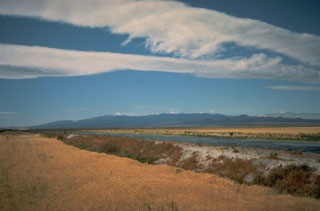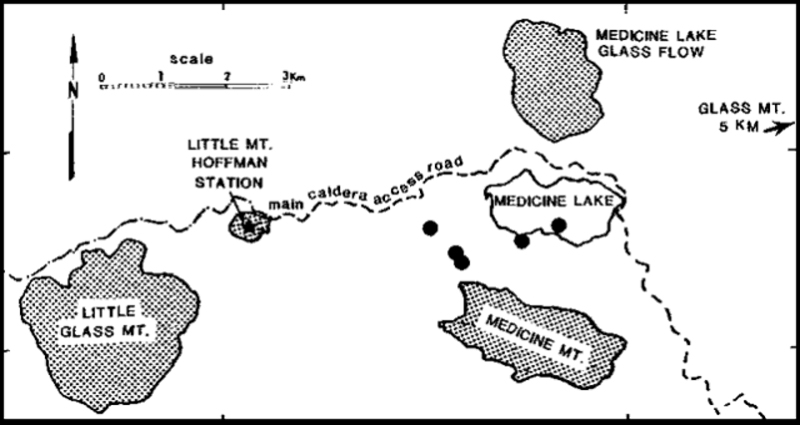Report on Medicine Lake (United States) — September 1988
Scientific Event Alert Network Bulletin, vol. 13, no. 9 (September 1988)
Managing Editor: Lindsay McClelland.
Medicine Lake (United States) Earthquake swarm but no inflation
Please cite this report as:
Global Volcanism Program, 1988. Report on Medicine Lake (United States) (McClelland, L., ed.). Scientific Event Alert Network Bulletin, 13:9. Smithsonian Institution. https://doi.org/10.5479/si.GVP.SEAN198809-323020
Medicine Lake
United States
41.611°N, 121.554°W; summit elev. 2412 m
All times are local (unless otherwise noted)
The quoted material is a report from Steve Walter. "On 29 September, 47 earthquakes were detected at Medicine Lake volcano, a large shield (50 km E of Mt. Shasta) that has experienced only 1 earthquake in the past eight years. The largest event (M 3.1) was located in the SW region of the caldera at a depth of 3.3 km (figure 1). Activity increased on 30 September when a total of 146 earthquakes were registered, 66 during a l-hour period. Four of these events (largest M 4.1) were located near the 29 September earthquake. After 30 September, seismicity declined to ~10 events/day until 4 October when there were 33 events, including a M 3.1 earthquake. Activity again declined with sporadic events (up to 5/day, M less than 2.0) continuing through 16 October. Most of the seismicity was recorded on the nearest instrument at Little Mt. Hoffman, ~4 km W of the epicentral zone. The next nearest stations are over 30 km from Medicine Lake in the Mt. Shasta network. On 3 October, a station was removed from the Mt. Shasta net and established at Medicine Mountain, ~1 km S of the epicentral zone on the S rim of the caldera. Although seismicity has declined, the USGS has selected six sites around the caldera for installation of one 3-component, low-gain, and six 1-component seismometers, scheduled for late October."
A levelling line, measured along the main caldera access road (figure 1) by Dan Dzurisin in August 1988, indicated at least 18 cm of deflation relative to a 1954 survey. Re-measurements of the same line in early October showed little or no additional deformation. Dzurisin and Phil Dawson attributed recent ground cracks, outside of the epicentral area and circumferential to Little Medicine Lake, as slumping possibly caused by the seismicity. No cracks were observed within the epicentral area, but recent tree falls were evident. Pre-existing weak fumarolic activity had not changed, although not all fumarolic areas were visited.
Geological Summary. Medicine Lake is a large Pleistocene-to-Holocene, basaltic-to-rhyolitic shield volcano east of the main axis of the Cascade Range. Volcanism, similar in style to that of Newberry volcano in Oregon, began less than one million years ago. A roughly 7 x 12 km caldera truncating the summit contains a lake that gives the volcano its name. A series of young eruptions lasting a few hundred years began about 10,500 years before present (BP) and produced 5 km3 of basaltic lava. Nine Holocene eruptions clustered during three eruptive episodes at about 5000, 3000, and 1000 years ago produced a chemically varied group of basaltic lava flows from flank vents and silicic obsidian flows from vents within the caldera and on the upper flanks. The last eruption produced the massive Glass Mountain obsidian flow on the E flank about 900 years BP. Lava Beds National Monument on the N flank of Medicine Lake shield volcano contains hundreds of lava-tube caves displaying a variety of spectacular lava-flow features, most of which are found in the voluminous Mammoth Crater lava flow, which extends in several lobes up to 24 km from the vent.
Information Contacts: S. Walter, USGS Menlo Park; D. Dzurisin, CVO.


